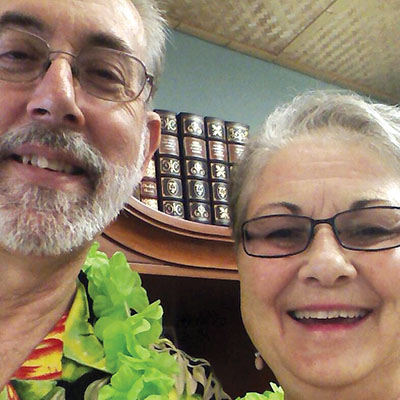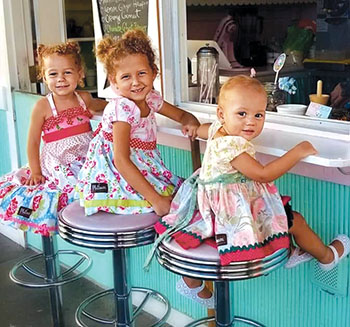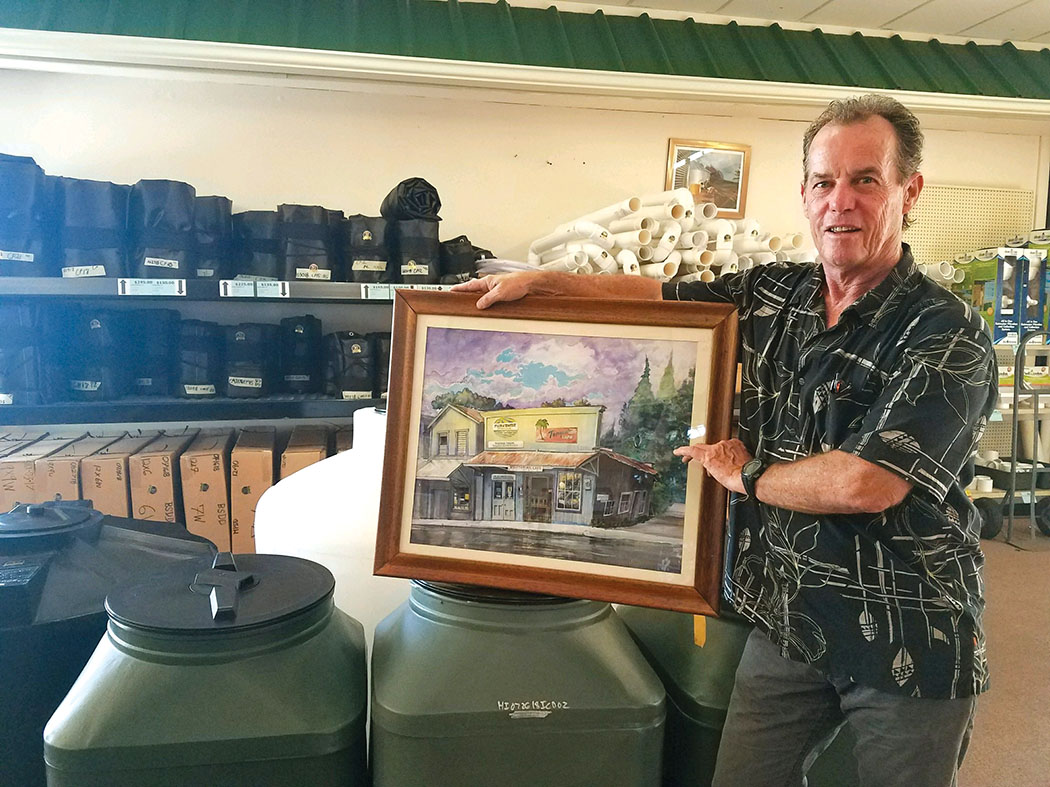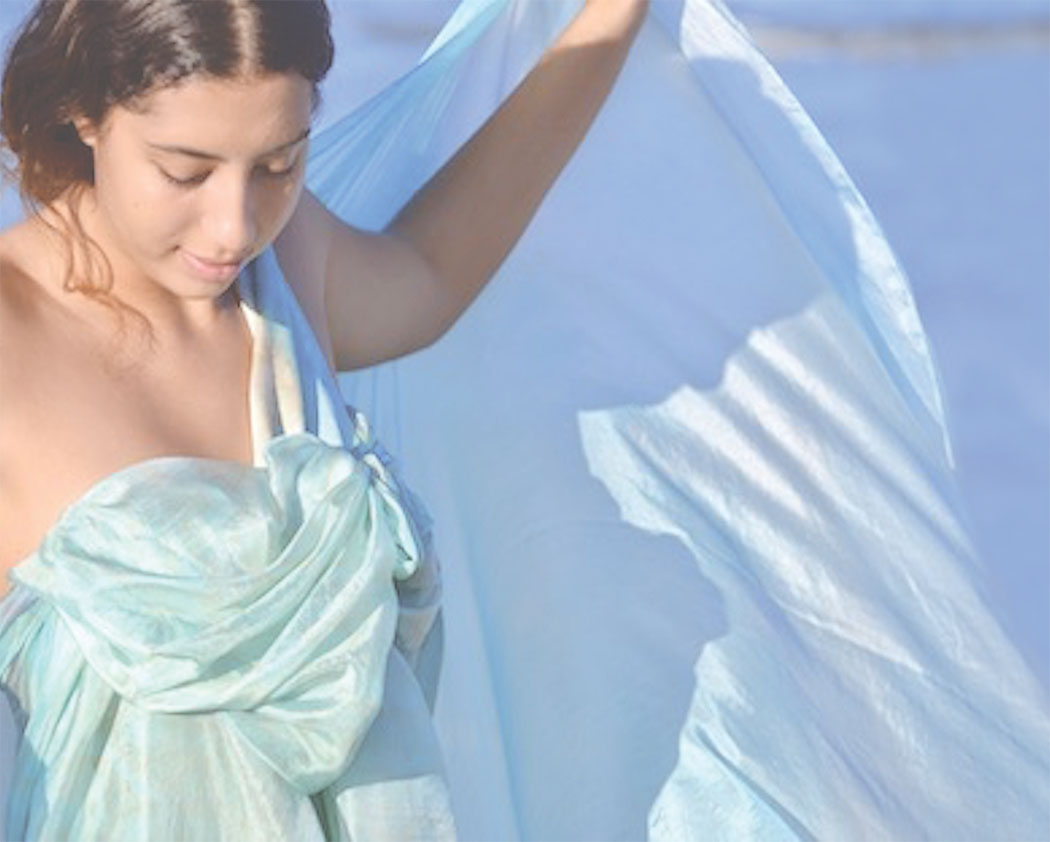
Fifty Shades of Blue: Artist Helen Nahoopii

By Ma‘ata Tukuafu
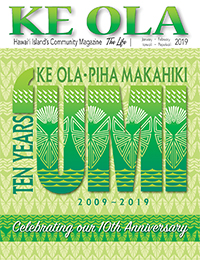
When Helen Nahoopii was a young girl, she was known as the “creative one” in the family. Her mother, a chemist and tax consultant, recognized that Helen saw the world in a unique way; she didn’t think linearly and didn’t take to numbers. Her mother encouraged Helen to be creative and become an artist.
In the early 1960s, Helen’s family lived in Hau‘ula on the north shore of O‘ahu. There, with her large Hawaiian family, she learned how to live simply, primarily because money was scarce. In 1967, the family moved to Pohoiki, here on Hawai‘i Island, and her parents rented a beach house (one of only three in the area) located in the ancient fishing village of Ahalanui.
“My earliest memory was to scavenge for driftwood, shells, beach glass, and Pele’s tears to make jewelry,” Helen says. “Later I became interested in creating abstract art on canvas, and experimented with different forms of fiber art.”
Helen explains that as a young woman she found great value in living simply because of economic reality; however, she also wanted a choice on how to live and thrive financially. She left Hawai‘i to pursue a formal college education, and eventually earned a BA in liberal arts. She continued to dabble in the arts, yet pursued a career as a marketing director for nonprofits and social causes close to her heart.
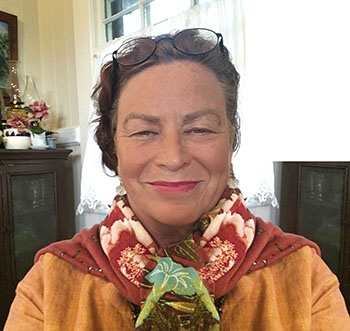
“It was something I could do to benefit the world. I was financially successful, but also, I learned to apply that knowledge to being creative,” says Helen. “Now I’m doing creative work and using business acumen to do my work.”
It was in 1982 that Helen started hand painting on silk. It reignited her desire for creativity but she didn’t have the time to pursue it. Fast forward to 2008 when the economy went south, and she turned to creating beautiful food. She and her partner Rayton Takata opened Ume Grill, a food truck in Eugene, Oregon that became extremely successful, moving from a food court to a bento lunch delivery to a permanent brick and mortar restaurant. They sold the business in 2014 and returned to Waimea where they purchased a plantation-style home, once owned by Parker Ranch employees.
Helen wanted to create jewelry, but purchasing jewels and components was expensive. She researched and found that shibori indigo dyeing was an affordable way to start her company. She created Indigo Blue Hawaii two years ago by taking out a $2000 business loan from PayPal, and began using the furo (bath) hut to house her vat.
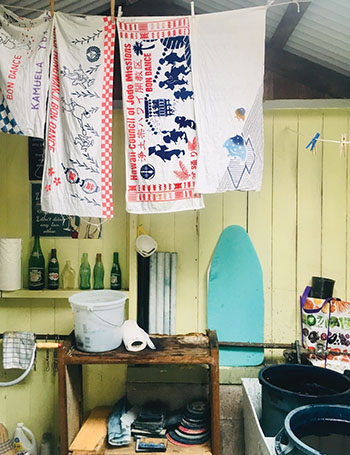
“Our house was owned by Auntie Ishihara and her husband Smoky. She was a crafter, and left behind all of her crafts as well as an old treadle sewing machine. Her craft room is now my creative space, and the old furo outside is where my dyeing vat resides,” Helen explains. “I’m very certain Auntie Ishihara is with me in spirit, and my studio is filled with antiquities from the Ishihara home.”
Her studio is filled with items found in the home: traditional slippers Mrs. Ishihara used to make, antiquities from pre-war Japan, a rice paddle for making mochi, baskets used for rinsing rice, and old soda and medicine bottles. By surrounding herself with items from the past, Helen says she is able to reflect on the elders who once lived there as well as how they lived simply and made creative use of what they had.
Although she has studied several fiber art-related disciplines over the course of her lifetime, Helen has chosen to use indigo dyeing as her preferred medium. In June of 2017, Helen began dyeing again, experimenting with indigo dye and shibori. The art of shibori is a pleat, fold, and bind technique to imbue patterns onto fabric. Last summer she attended a class by expert indigo dyer John Marshall to learn more and enhance what she knew. She obtains seedlings of the indigo plant from Sasha Duerr of Pāhoa, and now grows the indigo plant herself. Helen says indigo can actually be found in Waipi‘o and near the stream at the Kanehoa subdivision, most likely brought here by early Japanese settlers.
There are many indigo vat dye recipes, but Helen says she prefers a very traditional Japanese model: the iron, calcium, and natural indigo version. She learned this technique in 1982, and now prefers dyeing on silk fiber as well as the traditional cotton. She says the myth was that one couldn’t use indigo on silk, so she set out to prove that wrong. Within six months, from June to September of 2017, she was successful at silk and cotton dyeing and began to sell her art at the Waimea Town Market on Saturdays at Parker School.
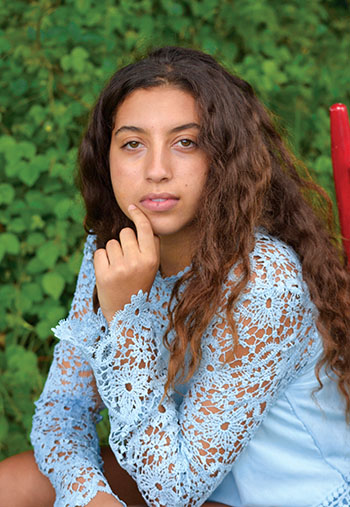
“Magic happens as I begin with a white surface, only to then manipulate it with hand paint, then iron pleats, folding, binding and then hand dipping the fabric into a green vat of indigo. It is exposed to air that oxygenates the fabric and turns it blue. The ultimate thrill is the end result and the element of visual surprise that lingers there,” says Helen.
Helen’s creations are beautiful, wearable, and functional items that are one of a kind. On any given Saturday, Helen’s booth offers three-foot-long pareo/sarongs, fabric napkins, kitchen towels, furoshiki (Japanese cloth that wraps things), scarves, and throw pillows. Some items are multi-functional: scarves that may be turned into wall hangings, or shawls that may function as room dividers. She does accept custom orders and also makes noren, door hangings that serve as privacy screens. Her art has also expanded to include other colors, by using French dyes that are hand painted onto parachute silk. She uses a bamboo steaming basket that sets the color into the silk fabric that can be washed with no dry-cleaning needed.
“Today I continue to explore the landscape in search of inspiration for creative endeavors,” Helen says.
Inspired by earth hues, Helen says all she needs to do is to drive from Waimea to Kona and back. On her drive, she sees sandy browns, black lava landscapes, and vibrant blue skies. The mountains of Maunaloa, Maunakea, and Hualālai inspire her fabric paintings. By transferring what she sees onto her textiles, Helen says the paint colors change into incredible multitudes of color and enhances the sheen of the natural fibers. She believes her art is abstract and emotes feeling, but at the same time, her marketing background grounds her into having to think about what customers want as well as how to make a decent living.
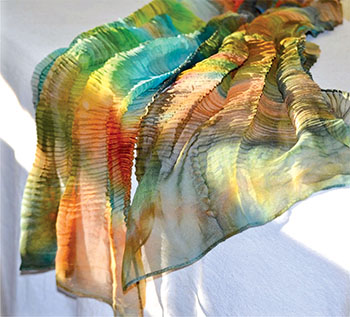
“I try different things and go in the direction where my heart is. Being both innovative and having a marketing background is a gift.” Helen says. “The possibilities of working with fiber are endless and there is always a teacher somewhere in the world to help me to go to the next level of the fiber art medium.”
It is important to note that Helen had a brain injury that greatly impacted her life. Three times she fell physically due to a stress-related condition called hyperventilation (a symptom of the collective traumatic events) and she felt she had to go through a physical transformation as a human being. She went into hiding with a fear of seeing people who knew her when she was financially successful and began to avoid relationships because she didn’t want to be exposed. By becoming a workaholic in her younger years, Helen says she was living a façade of being a woman of success.
“I had to go through a total transformation as a human being and allow my vulnerability to show through,” Helen explains. “At that moment, love happened. Life opened up. I had great therapy, and counselors who taught me to overcome physical, emotional, and mental obstacles. It allowed me to not only love and care for others, but also to begin another business.”
Helen now deals successfully with people every Saturday. Her attempt at overcoming the challenge of having a traumatic event happen in her life has also helped her rise up from that darkness to becoming successful as a professional person running her own creative business. Her insight two years ago to create her newest business was to envision possible successes and opportunities as well as the pitfalls that might occur. Helen adds that Rayton “has her back,” and that his support has been an immense positive in her life.
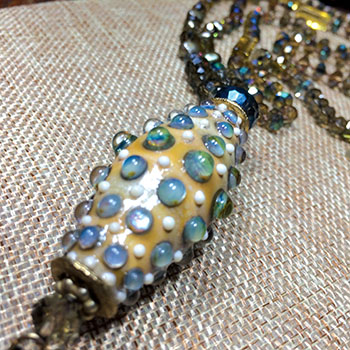
She has a personal relationship with her dyeing vat that she treats as a living person. Helen believes it is alive, that you must feed it, nurture it, and almost pray or meditate upon it to give it the strength to feed the creative process.
“These fermented leaves, and iron and calcium, you say thank you for this day. When the winds come through the furo windows, the oxygen in the room now elevates from a green surface to oxygenated liquid that creates the blues,” says Helen. “When the vat has expired, I then give it a proper burial. It’s my own process, not everyone’s, and it is a part of my life.”
At the age of 62, Helen is doing what she loves to do: creating beautiful, functional art, interacting with people, creating goodwill, using her marketing skills, and generating revenue.
“Do what makes you feel happy. People are down and out enough,” Helen says. “It’s a nice thing to be able to make someone’s day, because life is short.” ❖
Photos courtesy of Helen Nahoopii
For more information: indigobluehawaii.com
